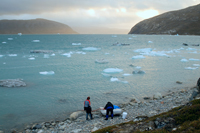So, what happened to the dye?
A week before Sarah Das left Greenland in late July, she dumped 9 pounds of harmless red powder into rushing water flowing toward a hole in the ice sheet. The bright red water quickly spread out, turning pink as it mixed into the stream water and surged a quarter-mile downstream, disappearing into the hole. Sarah’s goal was to see if even a few specks of dye, dissolved into millions of gallons of water, would eventually flow down through more than a half-mile of ice, over bedrock, and out to the coast, about 25 miles (40 kilometers) away.
Sarah had never tried an experiment to trace water flow under such a long stretch of Greenland’s ice sheet; to her knowledge, no one had. But she saw a perfect opportunity to try. One of her students, Maya Bhatia, was working at the ice edge for her own thesis research, close to the area where Sarah suspected the water may flow out from under the ice sheet and into to the ocean. Maya could look out for the dye on the coast while Sarah continued her work inland on the ice.
Each day after Sarah dumped the dye, she spoke by satellite phone with Maya, who was making daily trips in a rubber dinghy with two colleagues across the 3-mile (5-kilometer)-wide, iceberg-studded, and often windswept fjord. She searched for signs of the dye using a sensitive instrument called a fluorometer, a device that detects tiny (as small as one part per trillion) concentrations of the fluorescent, non-toxic chemical dye contained in water.
Maya, with colleagues Matt Evans and Alison Criscitiello, took the dinghy out as often as every four hours. A hose sucked in water as they moved across the fjord, and Maya recalled the she would watch the computer’s readout for any flicker of detection. Finally, after seven days, their time on the edge of the ice sheet ended, and they had to leave for home. They never saw signs of the dye.
“We’re not morose and disappointed,” Sarah said in September. “There was a small chance of finding it to begin with, and we’re glad we tried.”
As global temperatures increase, Sarah and other researchers wonder what this means for Greenland’s ice sheet. One theory is that more melted water on top of the ice sheet could flow through holes on the ice, called moulins, and down to the bedrock, where it could act like grease, causing the ice sheet on top of it to flow faster to the coast. But Sarah and her colleagues can’t lift up Greenland’s massive ice sheet and see what is happening there. So the goal of the dye experiment was to help paint a picture to help them see flow patterns under the ice.
“The speed of the water under the ice tells us what sort of water system is under the ice, this is important for understanding how the impact of more water—say, with more global warming—will further impact the speed-up of the ice sheet,” Das said.
Sarah and her colleagues did have a general idea of what direction the dyed water would flow, based on satellite images that captured how the out-flowing glaciers in their study area flowed northwest, out to sea. This allowed Sarah to make an educated guess as to where to put in the dye, and where it might appear.
Despite the results, Sarah said they learned a lot from the experiment. “Not finding the dye tells us something; we were either in the wrong place, or looking at the wrong time,” she said. “We didn’t have a lot of wiggle room this year. We had to try at the places where we would already have people and for the times we would already have people in Greenland.”







